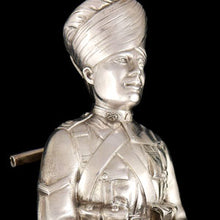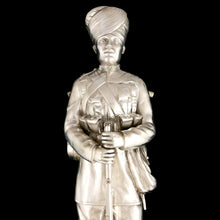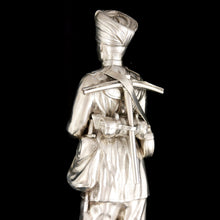128th Pioneers - A George V Regimental Presentation Figure, 1921
Adding product to your cart
Height overall: 37cm (14.5in)
Silver. Standing figure of a Lance Naik in Marching Order mounted on an ebonised base, applied with a presentation plaque inscribed ‘Presented to / The Officers / 128th Pioneers / by / Captain A. Campbell Munro I.M.S. / Sitapur 1914’. Maker’s mark of Garrard & Co.,112 Regent Street, London. Figure height: 25cm (9.9in). Hallmarked London 1921.
Read more
The 128th Pioneers were raised at Ahmednuggur in 1846 as the 28th Regiment of Bombay Native Infantry. It saw action in the Second Afghan War at the Battle of Kandahar. In 1885, they were sent to Egypt to take part in the Sudan Campaign. They played an active part in the Battle of Tofrek and the Battle of Suakin. On their return to India they were part of the force gathered for the Tirah Campaign in 1897. The regiment became the 128th Pioneers in 1903 and the 3rd Battalion 2nd Bombay Pioneers in 1922. In 1914 it’s companies were composed of Yusufzais, Rajputana Musalmans, Sikhs and Dekhani Mahrattas. The 128th Pioneers were stationed at Sitapur when the First World War began in August 1914, at the regiment was condsidered by the Major-General commanding the Meerut Division, ‘well instructed and trained; manoeuvres well and steadily in the field; musketry satisfactory; pioneer work very good and thorough; trenching, road-making and bridging very satisfactory. The Director-General of Military Works informed me that he also was very pleased with the bridging, entrenching, platelaying and demolitions… Generally a good battalion with a good record in which it takes a proper pride. Works well as infantry in addition to being good at all pioneer work. … Thoroughly fit for service both as infantry and pioneers.’
In October 1914 the 128th Pioneers sailed from Bombay to for Egypt sailed in the Hired Transport Monteagle. They arrived at Suez, Egypt on 18 November 1914 and moved into camp at the Serapeum Post between Lake Timsah and the Great Bitter Lake. The Pioneers remained there apart from a brief period at Moscar until in moved to Ismailia in March 1915. The Regiment helped to repel the Turkish attack on the Suez Canal on 2/3 February 1915, when a German-led Ottoman Army force advanced from Southern Palestine to attack the protected Suez Canal, marking the beginning of the Sinai and Palestine Campaign (1915–1918). Substantial Ottoman forces crossed the Sinai peninsula, and though a few managed to cross the Canal, the entire attack failed – mainly because of strongly held defences and alert defenders.
In December 1915, the 128th Pioneers left Egypt for Mesopotamia (Iraq), where the 6th (Poona) Division was under siege in the town of Kut-al-Am-ara. The Regiment took part in the failed attempts to relieve the Kut garrison and after its surrender helped improve the trenches in the Sannaiyat position. In June 1916, the Pioneers joined the 7th Brigade, 3rd Division, and from June till December dug many wells in the Dujaila depression, worked on railway construction sometimes temperatures of up to 120 degrees F and amidst and built blockhouses to protect the it from marauding Arabs. History of the Bombay Pioneers 1777-1933 by Lieutenant-Colonel W. B. P. Tugwell.
Archibald Campbell Munro (1886-) was educated at the universities of Glasgow and Cambridge and was commissioned into Indian Medical Service in 1911. During the First World War he served on the Western Front and in Mesopotamia where he his duties took him deep into tribal lands, helping to foster their habitual hostility towards the Ottoman Turks in exchange for medical aid. (Mentioned in Despatches, London Gazette 7 February 1919. An account of his expedition into the the Sinjar Hills west of Mosul was published in the Scottish Geographical Journal in 1921. In the 1920s he was appointed Senior Medical Officer at Landikotal, North-West Frontier. In 1941, during the bleakest phase of the Japanese assault on India, and amid a critical shortage of medical supplies across the Subcontinent, Munro was appointed Director of Medical Services for India. Notwithstanding the wartime difficulties, he won the confidence of the Viceroy Lord Wavell, and was again mentioned in despatches (London Gazette 16 December 1943). Munro was appointed a Companion of the Bath and held the position of Honorary Physician to the King from 1939 to 1943.










